Henry Parker buried with full military honours on the Somme
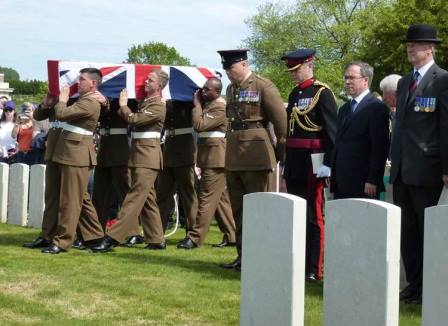
The bearer party at Henry Parker's funeral on May 17 2017. Crown Copyright
Wansford First World War warrior Henry Parker was buried at the Warlencourt British Cemetery, the Somme on Wednesday May 17 2017, more than a centure after he died halfway through the Battle of the Somme which lasted 141 days from July 1 1916. Hitherto, Henry's name has been on the Thiepval Memorial To The Missing Of The Somme.
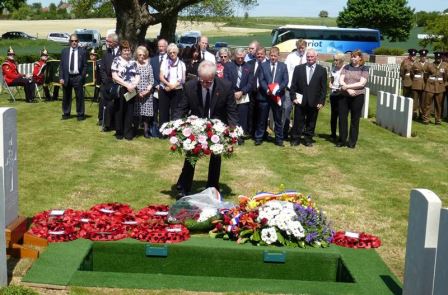
Members of Henry Parker's family at the graveside in France. Crown Copyright
Flag presented to Wansford at service for Henry Parker
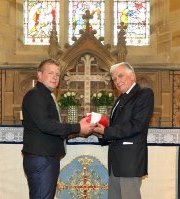
Martin Parker hands over the flag to Wansford churchwarden John Seaton
There were echoes of the 1916 memorial service at a service in Wansford Church on Saturday May 27 2017 for World War One soldier Pte Henry Parker, whose remains were discovered on the Somme in 2015.
The service to honour the memory of villager Henry Parker, a member of the 5th Battalion, Yorkshire Regiment, was led by Canon Richard Cooper, who is chaplain to the Green Howards and a chaplain to the Queen.
To an extent, the service shadowed the funeral service at the Warlencourt British Cemetery, France, on May 17 with the some of the same readings by members of the family.
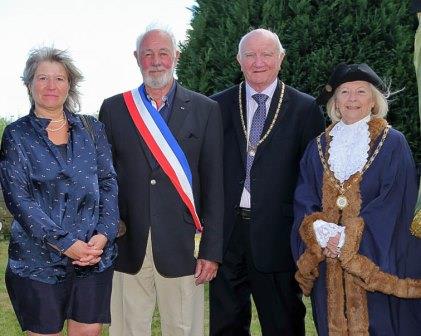
Mme Isabelle Guise, M Lucien Guise, mayor of Warlencourteaucourt, the Somme, Chad Chadwick and ERYC vice-chairman Coun Mrs Margaret Chadwick after the service. Pictures courtesy of MSH Photography.
The mayor of Warlencourteaucourt, M Lucien Guise, who had been heavily involved with the Ministry of Defence in organising the funeral, travelled from the Somme to Yorkshire for the commemoration with his wife, Isabelle.
Also attending the service was the vice-chairman of the East Riding of Yorkshire Council, Coun Mrs Margaret Chadwick, and her husband, Ernest.
The flag in which Pte Parker’s coffin was dressed was presented to St Mary’s Church by his great, great nephew Martin Parker, who received it at the funeral. The artefacts found with Pte Parker’s remains were presented to Steve Erskine, assistant curator of the Green Howards Museum in Richmond.
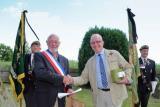
Steve Erskine presents M Guise with a book about the Green Howards
Henry died near Martinpuich on September 26 1916, three days short of his 23rd birthday and halfway through the bloodiest battle of the war.
Until now he has been commemorated on the Thiepval Memorial To The Missing Of The Somme but now, being buried alongside his comrades at last, his name is to be removed from the panels there.
Henry was the seventh of the 12 children of John and Esther Parker, who moved to Wansford in April 1896 after living in various villages on the Yorkshire Wolds – North Cave, Middleton, Kilham and Weaverthorpe. Members of the family continued to live in Wansford until the 1970s and many of the extended family, many of whom both attended his military funeral and thge memorial service still live in the area today.
Altogether, 36 of Wansford’s young men went to war – and are on the Roll of Honour in Wansford Church – and four did not return. They were Pte Parker, his neighbour Elijah Baggley, who, having no known grave, is commemorated on the Menin Gate, and George Watts, who is buried in the Bancourt British Cemetery on the Somme. Cecil Ullyott, who is on the roll of honour but commemorated on the Harpham war memorial, is buried in the Connaught Road cemetery, Thiepval.
* At the conclusion of his weekend-long visit to Wansford, Skerne and Wansford Parish Council chairman Ian Lamble presented M Guise with a painting of the village church.
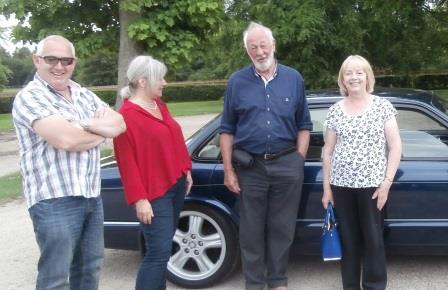
Parish council chairman Ian Lamble, Isabelle Manbon, Lucien Guise, mayor of Warlen-Eaucourt and parish council vice-chairman Jackie Dobson.
The Entente Cordiale
As work was going on in London, Gloucestershire, Richmond and Wansford to establish Pte Henry Parker’s identity, his place in the First World War, the Yorkshire Regiment, his family and our village community, Skerne and Wansford Parish Council’s French counterparts on the Somme were working equally hard to ensure that all went well at the military funeral at the Warlencourt British Cemetery.
The mayor of Warlencourt-Eaucourt (population 155), Lucien Guise, was liaising with various French authorities and the Ministry of Defence Joint Casualty and Compassionate Centre (JCCC) so that this son of Wansford could have a fitting and dignified service and, 101 years on, be laid to rest alongside his fellow First World War comrades.
Bev Simon, of the JCCC, said: ‘M le Maire had to attend meetings at a very high level when planning started way back in October 2016. He volunteered his village hall, chairs, etc and manpower was provided from his village. It was also an enormous occasion for them to have the Sous-Prefet present and the British Ambassador to France, Lord Ed Llewellyn.
‘I think it was probably obvious from his speech, but the village was immensely proud to support the burial and to open its doors to us. Personally, I could not thank him enough as I felt this tiny village had responded so positively when we had descended upon them.’
At the reception at the Warlencourt-Eaucourt Mairie following Pte Parker’s funeral, upon hearing of the memorial service scheduled to take place in Wansford the following week, M Guise, a non-English speaker who had never before visited the UK, indicated that he wished to attend.
So, with the great help of the JCCC and in the course of just a few rushed days, the details were arranged and the parish’s first ever civic visit was sorted.
Villagers and church members, having already given time, talents and a great deal of effort to ensure the Pte Parker’s memorial service and the English reception was a success, then rallied round with time, language and culinary skills, to welcome and help entertain M le Maire and his partner, Isabelle, throughout the weekend, starting with a hurriedly arranged meal at the Trout and carrying on from there. At a gathering on the Sunday evening, parish council chairman Ian Lamble presented Lucien and Isabelle with a painting of Wansford Church, as a reminder of, and a thank
you for, their involvement in the Henry Parker story and their visit to East Yorkshire.
Ian would like to thank everyone involved in the weekend in any way.
He said: “My memories of the Pte Henry Parker memorial weekend will never fade, not only for remembering one of Wansford’s own, but also for how our village pulled together to make our first visiting foreign dignitaries, M le Maire—Lucien—and his partner, Isabelle, most welcome despite the language barrier.
‘My personal thanks go to all those who translated and those who gave their own time and efforts over the weekend to show great Yorkshire hospitality.’
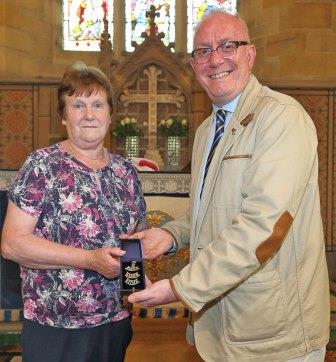
Henry Parker's great niece, Wansford-born Marjorie Almond presented the artefacts found with Henry's remains to Steve Erskine, assistant curator at the Green Howards Museum at the memorial service at St Mary's Church, Wansford.
Pride of place for Henry Parker
A North Yorkshire museum, whose research was instrumental in the quest to name an unknown First World War soldier, has put on display some of the objects which helped identify him.
Items found with the remains of Private Henry Parker, whose childhood home was in The Square, Wansford, including a belt buckle, buttons, shoulder badges and a cut-throat razor (pictured below), have been donated to The Green Howards Museum by his family and are now available to view, free of charge, in the entrance gallery of the museum in Richmond.
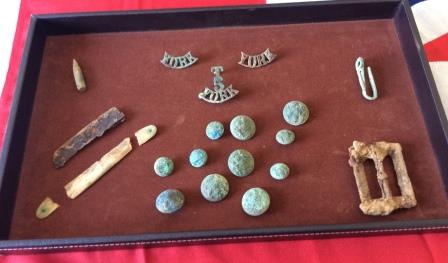
“Human remains were found in a field near the village of Martinpuich on the Somme and we were contacted by the Ministry of Defence’s Joint Casualty and Compassionate Centre (JCCC) at the end of 2015 to see if we could help,” explains the museum’s Director and Curator, Lynda Powell. “396 men from the regiment had died in or around the location where the remains had been found, but we gradually reduced the number of possible candidates down to 12. The shoulder badges showing that he was a territorial soldier in the 5th Battalion had helped in that process of elimination. Our archive information and research had played their part; next, we simply had to wait and hope that the soldier who had been discovered was one of ‘ours’.”
Next, the JCCC’s forensic team took DNA from the femur of the remains and compared it to that belonging to family members of some of the shortlisted soldiers who had agreed to be tested. DNA from Henry's great-nephew, Francis Storry, who was born in Wansford but now lives in Nafferton, proved to be a match.
Private Parker, who died, age 22 on 26 September 1916 during the Battle of the Somme, was reburied with full military honours, at Warlencourt Cemetery in France, on 17 May 2017, with 25 members of his family in attendance. A memorial service in Wansford followed at which two boxes, containing the items which had lain with Henry in that field in France for the last 100 years, were given to the museum by the modern-day Parker family.
“It feels really special to handle these items which are not only so very old, but which also link to a real person whose identity is finally known,” says Olivia Wallis, A-level history student at Richmond School, currently on work placement at the museum. “The whole Henry Parker story is fascinating to me in the way that it has linked this soldier who was ‘lost’ for so long, with his modern day family and a whole network of people who have been involved in finding him, want to learn more about him, and make sure his sacrifice is not forgotten. It’s reinforced to me that history is always relevant, and it’s always human.”
The Green Howards Museum is open seven days a week until the end of August between 10am and 4.30pm.
The story of Henry's discovery
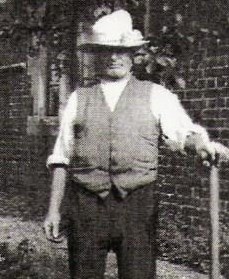
Henry's father, John, working in the Wansford Vicarage garden.
For almost a century an East Riding soldier’s remains lay where he fell, in a foreign field on the Somme, on September 26 1916 – halfway through the bloodiest battle of the First World War.
He became one of that war’s missing half a million soldiers - mainly young men – with no known grave, whose lives are commemorated on memorials in many theatres of war worldwide.
His name is etched on the Thiepval Memorial to the missing of the Somme, along with those of 72,000 others, 90 per cent of whom died between July 1 and November 18 1916.
But now, thanks to the French farmer who found his remains, the diligence of military historians who narrowed the search down to the names of just 12 missing men and DNA specialists who confirmed the identification and traced his history, Private Henry Parker 3183, 5th Battalion, East Yorkshire Regiment and of Wansford, near Driffield, is to have a grave and a focus for his family.
Henry Parker, born September 29 1893, at Weaverthorpe, was one of the 12 children of John and Esther Parker (nee Berriman), who were all born between 1882 and 1903.
John Parker was a farmworker – in those days annual hiring fairs took place in November each year, with Driffield, Bridlington, Pocklington and Beverley being a handful of the East Riding towns which held a fair where agricultural workers would gather to bargain with prospective employers and, hopefully, secure a position for the coming year.
Thus, the children of John and Esther, who were married in Driffield, were born in villages scattered around the Yorkshire Wolds – North Cave, Middleton-on-the-Wolds, Kilham and Weaverthorpe. In late 1896 the family - by then they had eight children, Tamar, Richard, Mary, Thomas, Rosina, James, Henry and Alice, moved to Wansford - and settled. Four more children were born in the village – Eva Louie, Minnie, Jessie and Ernest.
They lived in The Square – two blocks of six cottages in an L-shape. The cottages, which are believed to have been built in the late 1700s for Irish navvies working on the Driffield Navigation, had no sanitation and the only source of fresh water was the spring between the two terraces.
The family’s move to Wansford came, presumably, straight after the Michaelmas hirings, with James Parker, aged four and a half being registered at Wansford School on November 9. Henry followed him in July 1897, not long after the eldest of Parker boys, Richard, had left, aged barely 14.
By the time that Henry was enrolled, the school had been in its new, larger premises on Nafferton Road for almost 20 years, having opened in 1879. It was designed by eminent architect G E Street after being commissioned, along with St Mary’s Church, the Vicarage and the schoolhouse, by Sir Tatton Sykes of Sledmere, who owned the village at that time. Mr James Holtby was the schoolmaster.
Children came and went as their farmworker fathers moved from village to village and attendance was erratic. Between 1897 and 1914 outbreaks of scarlet fever, whooping cough, diphtheria, influenza, measles and ‘eruptions of the skin’ were regular; often, in bad weather, the children from outlying Brigham and Skerne did not turn up. Moreover, many of the older boys had more pressing things to do…farm work.
There was a three-week holiday each June so the children could work in the fields – weeding, etc. Subsequently, if hay time extended beyond the date that school resumed, the ‘upper standard boys’ would not return.
School ceased again for four weeks towards the end of August for the ‘harvest holidays’ but James Holtby noted on September 29 1902: ‘Resumed school this morning but the harvest is not finished; consequently, the children have not returned in full numbers.’
In June 1905, he complained: ‘This system of allowing children off lessons in summer months is neither just to the child nor to the teacher.’
It is likely that Henry left the school in 1907 but there is no record, probably because his 14th birthday was in the harvest holidays and he simply did not return after the break. He found work first as a ploughboy and later as a horseman and by the 1911 census he was working at Swaythorpe Farm, near Rudston, and living in Kilham.
However, on January 8 1915, when Henry enlisted in the Territorial Force 5th Battalion of the Yorkshire Regiment he was back at the family home in Wansford. In spite of his signing the Territorial’s Imperial Service Obligation for service in the theatre of war, he was not sent abroad until November 1 1915, when he crossed to France and was then moved on into Belgium to join his battalion in the field as part of a draft of reinforcements. His colleagues had been at Armentieres, near Ypres, since April of that year.
So, that Christmas - his last Christmas - Henry was in Flanders. Back on the home front in Wansford, 36 young men from 25 of the village’s families had gone to war and villagers were mindful of their circumstances. During the year, between 96 and 366 eggs a week were being collected from villagers for wounded servicemen and were despatched at nearby Nafferton Station by the vicar, Canon Albert Earle. For Christmas, villagers determined to send each of their young men a festive parcel. Henry’s address for the purpose is recorded as ‘5 Yorks Regiment, 3 Entrenching Battalion, A Company, British Expeditionary Force’.
The battalion continued to serve in the Ypres Salient until early August 1916 when it was redeployed from Flanders to the Somme, along with the other units of the 50th (Northumbrian) Division. Thus, they missed the costly opening of that battle when more than 19,000 British soldiers died on the first day (July 1) and another 39,000 were wounded. It was recorded as the worst day in British military history; during the ensuing two weeks, another 25,000 men were killed or wounded.
Records show that on September 10, the 5th Battalion moved from Corps reserve at Millencourt, to Lozenge Wood, then on to Pioneer Alley and Swansea Trenches. On September 26, it relieved the 5th Durham Light Infantry in Prue Trench and the Starfish Line and was involved in an advance towards Flers. Henry did not come back.
At home in Wansford, an announcement in the district column of the Driffield Times read: ‘News has been received that Pte Henry Parker, son of Mr and Mrs Parker of this village, was killed in action on September 26. Much sympathy is felt for the family. Another son has been at the front since the commencement of the war.’
At the end of October 1916, Canon Earle organised a memorial service for Henry. In the district column of the Driffield Times October 28 edition, the Wansford correspondent (very likely schoolmaster James Holtby) records: ‘The church was crowded on Sunday when a memorial service for Pte Henry Parker, who was killed in action…, was held. The service was most impressive, the Rev A Earle giving a sympathetic and comforting address.’
In the same edition, Henry’s ‘loving father, mother, sisters and brothers’ placed a death notice, which finished with the verse: ‘We often sit and think of him and wonder how he died; To think he could not say goodbye before he closed his eyes.’
At the end of the 141-day Somme offensive, on November 18 1916, there had been an estimated 420,000 British casualties and 12 kilometres of ground had been gained.
When the war was over Canon Earle initiated the placing of a memorial to Wansford’s lost young men in St Mary’s Church. This was dedicated at a 6.30pm service on November 7 1920 by Canon Earle and unveiled by Major Ralph Butterell MC, of the Machine Gun Corps, whose family lived at Manor House until the 1990s.
In his address Major Butterell said: ‘As one who spent nearly four years almost without intermission amongst these soldiers, who were constantly opposed to the attacks of a ruthless enemy, I can well testify to their great bravery, their unfailing and unswerving devotion to duty, and their cheerful willingness to sacrifice all for the safeguarding of those dear to them on the homeland…Wansford will always be associated in my mind with the happiest memories of my early life, but the proudest memory of them all will be the thought that I was considered by its people as one worthy to lift the veil from the record of its glorious dead, a record that will last for all time, and tell its story to men of Wansford…’
Two other First World War casualties are commemorated on the memorial: George William Watts, who also lost his life on the Somme battlefields and was one of Henry’s neighbours in The Square, and Elijah Baggley, again of The Square, who died in Flanders on July 22 1916, shortly before Henry’s redeployment to the Somme. Elijah, son of postman Tom Baggley, is commemorated on the Menin Gate and George, a member of the East Yorkshire Regiment, is buried in the Bancourt British Cemetery. Cecil Ullyott, also of the 5th Battalion Yorkshire Regiment died on the Somme and is buried in the Connaught Cemetery, Thiepval. His name is on the war memorial at the St John of Beverley Church in Harpham. However, Cecil lived at Cattleholmes and attended Wansford School.
The cessation of hostilities saw James Parker, who had enlisted in August 1914, returning safely, having fought in every major engagement of the war except the Battle of Loos.
A paragraph in the Driffield Times Wansford news section on January 11 1919 reads: ‘Gunner J Parker is on leave from the front here he has been on active service since the beginning of the war, and is one of the ‘old contemptibles’. At least one other of the Parker brothers, Thomas, saw active service and returned home safely. He died in June 1951 aged 62. Thomas, who had married in 1910 and followed work around the Riding, thus living in various villages, is not named on the roll of honour in St Mary’s Church, which lists all those living in Wansford in the war years who served in the conflict.
Members of the Parker family continued to live in the village, with father John serving as St Mary’s Church warden and, in retirement, working as gardener and handyman for Canon Earle. His granddaughter, Margaret Parker, of Kilham, recalls how family folklore tells how Canon Earle thought highly of ‘grandad’. In 1932, when daughter Eva Louie was married at Wansford Church to George Monkman, of Warter, her father’s occupation was recorded on the marriage certificate as ‘church verger and sexton’. John died in 1938, aged about 77, just as another great war was threatening and politicians were talking of appeasement. Esther died in 1940, a year into the Second World War, without ever knowing her son Henry’s resting place.
Their daughter – Henry’s sister – Minnie, who never married, stayed on in The Square until ill health took its toll in the 1970s. She died in a home in Bridlington in 1978. Granddaughter, Kathleen, was married to Harold Storry at Wansford Church in 1940 and they made their first home in the village before moving to Millingdale, where the family lived for more than 20 years.
And so life went on – the family multiplied; many stayed in the Driffield area and some still live in Nafferton today. Then, in October 2016, the soil of a farmer’s field to the north-east of Martinpuich on the Somme yielded up a relatively full set of remains. Regimental shoulder titles and a shoulder badge indicated that the soldier had been a member of the 5th Battalion Yorkshire Regiment.
The regiment’s official title was The Green Howards (Alexandra, Princess of Wales’s Own Yorkshire Regiment), an infantry division of the British Army which recruited mainly in North and East Yorkshire. Following the discovery, the Green Howards, which has a regimental museum in Richmond, were contacted by the Joint Casualty and Compassionate Centre (JCCC) of the Ministry of Defence and asked if there was anything that could be done to help to give this soldier a name. (When remains are found of British service personnel killed in historic campaigns, the JCCC co-ordinates efforts to identify the remains working with the host nation, Commonwealth War Graves Commission, service historic branches and regimental contacts.)
The opinion of the exhumation team was that the soldier was lying where he fell, perhaps blown onto the side of a shell hole.
And so began a research quest that engrossed staff and volunteers as they focused on giving the remains some humanity. ‘After all, what could be more worthwhile than giving our energy to giving a man a grave and a family a focus for their remembrance?’ the Green Howards researchers comment on their website.
They looked at events around Martinpuich between September 25 and 27 1916, ascertaining the number of missing on those days.
Casualties recorded on September 25 were five officers and 62 other ranks killed, three officers and 256 other ranks wounded with 27 other ranks listed as ‘missing’.
On September 26 three officers and seven other ranks of the 5th Battalion were killed, with 33 other ranks wounded or missing – Henry being among them.
After painstaking work they reduced the number of candidates to 12: 3763 Private John Richard Cooper; 3630 Private Edward Cross; 1123 Private John Holmes; 3804 Private Charles Jesse Holt; 1281 Private Harold Johnson; 2743 Corporal Arthur Lyth; 242489 Private John Reuben; 3183 Private Henry Parker; 3837 Private George Perks 240587 Private Maurice Pilgrim; 5233 Private Arthur George Redding; 1875 Lance-Sergeant Arthur Warley.
The paper archive being exhausted, science took over.
The JCCC forensic team travelled to the mortuary in France and collected DNA from the femur of the remains. This was tested and compared to samples taken from the next of kin of the missing soldiers who agreed to take part in the process. These included one of Henry’s great nephews, Wansford-born Francis Storry, whose home is in Nafferton.
Then, on February 10 2017, the remains were positively identified as those of 3183 Private Henry Parker – John and Esther Parker’s lost son…
Henry’s name will now be removed from the panels at the Thiepval Memorial. He will be reburied, with full military honours on Wednesday May 17, at Warlencourt Cemetery near Longueval. Skerne and Wansford Parish Council, St Mary’s Church Parochial Church Council and the people of Wansford will be represented at the service.
With acknowledgements to the Green Howards Museum, Richmond (http://greenhowards.org.uk), Wansford – Back To Its Roots by Sheila Cadman
.